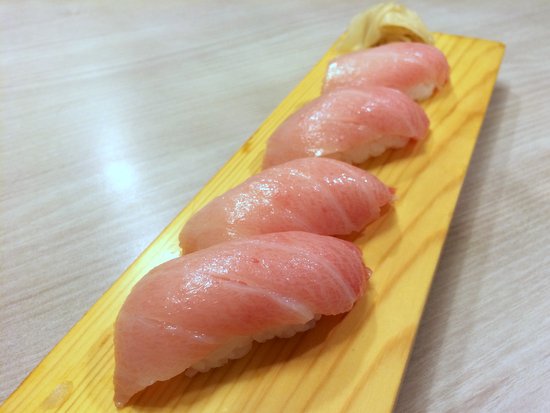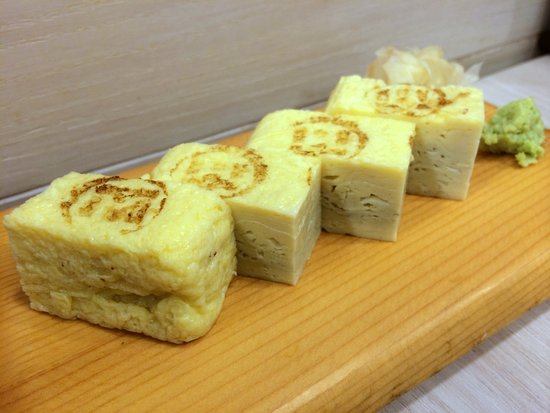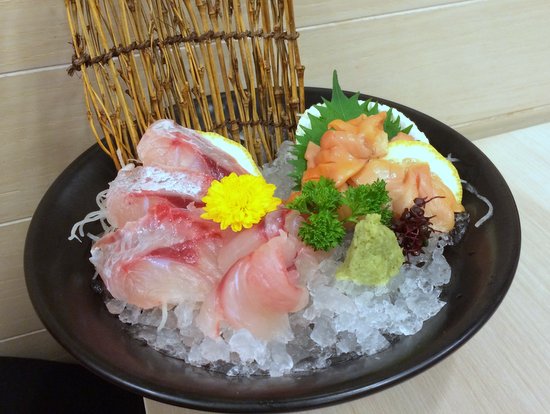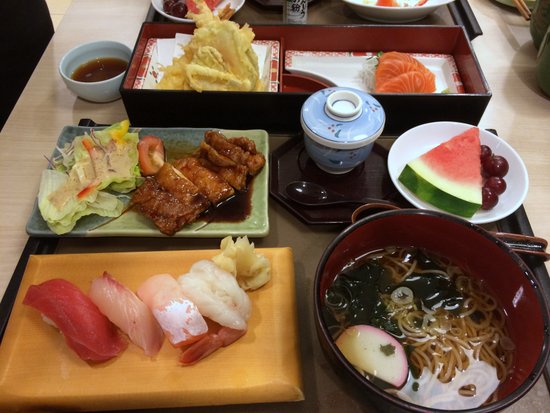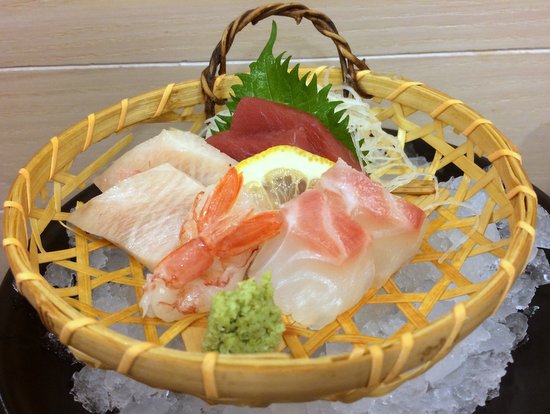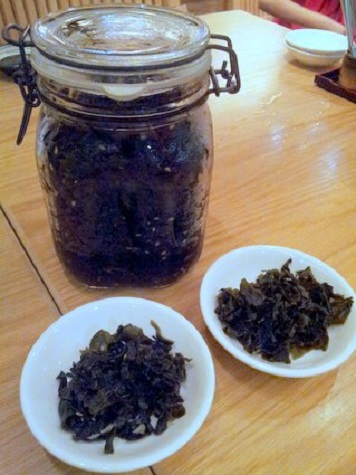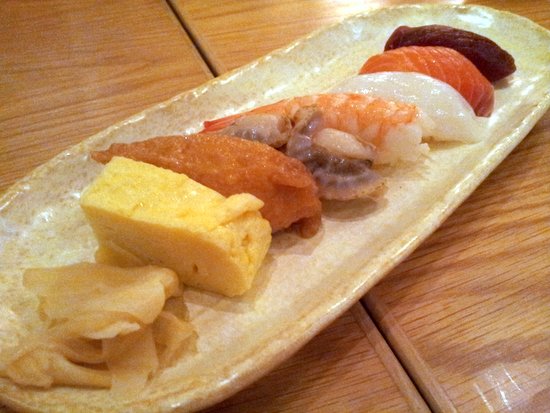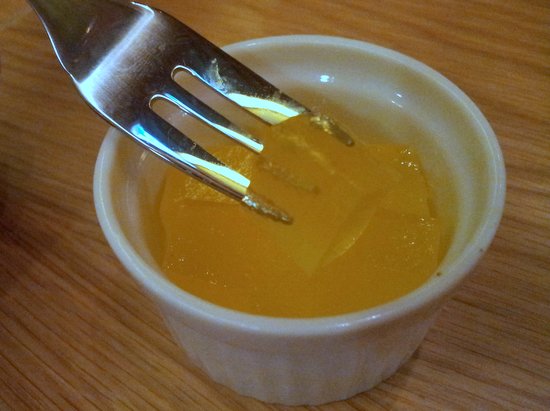Lunch @ Shinji by Kanesaka (Raffles Hotel)
April 3, 2015 in Japanese
I’ve long heard about the Japanese restaurant at Raffles Hotel. Oh yes, I’m referring to Shinji by Kanesaka. Friends who have dined at Shinji raved about their sushi. They said I haven’t quite tasted sushi till I tried Shinji. But with my stubbornness of not wanting to check out restaurants that’re located within hotels, it has taken me a long while to finally visit Shinji. Haha. And with that, reservation was made for lunch on a Saturday. Reservation is a must, by the way.
Taken from Shinji’s website, Shinji is an extension of 2 Michelin stars chef Shinji Kanesaka’s edo-style sushi restaurant and it’s his first venture outside Japan. Omakase menu is executed by a native Japanese team of artisan chefs with head chef Koichiro Oshino at the helm. And head chef Oshino has worked with master chef Kanesaka for more than 20 years.
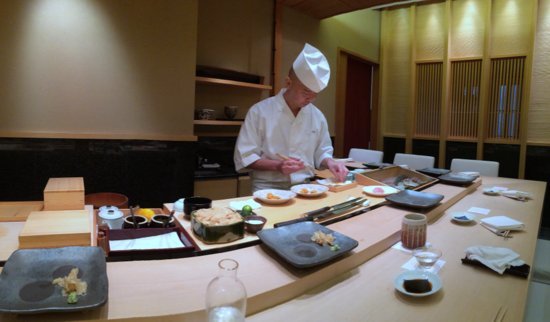
Upon entry, one would enter the counter area which could sit up to 15 people. There’re private rooms too, but I believe the entrance to the private rooms are different cause halfway through our lunch, the chefs began preparing food for a big group. But I did not see the big group walk in. And it’s brilliant that there were different entrances to minimise disturbance to our dining experience. Taken from Shinji’s website again, the restaurant was designed by Junzo Irikado, with organic materials like wood and paper flown in from Japan to provide for the restaurant’s furnishing and fixtures. And one highlight is the restaurant’s main sushi counter which was singularly carved from the trunk of a 220-year-old Japanese cypress or hinoki tree.
And from the menu (pages 1, 2), we ordered:-
1) Omakase special (yume), $250 comprised of appetiser, assorted sashimi, assorted cooked dishes, nigiri sushi and maki sushi, soup and Japanese fruit:-

(A) Tai (above) – Snapper.
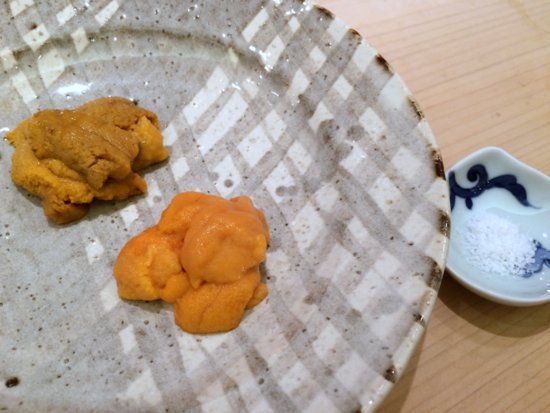
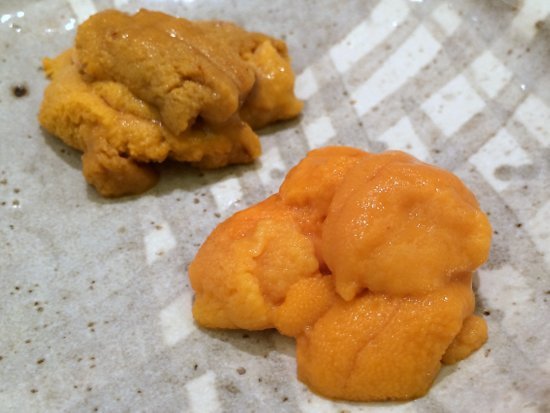
(B) Bafun-uni (foreground), murasaki-uni (background) (above) – Short spine sea urchin, violet sea urchin. Salt was also given to be used sparingly to enhance the sweetness of the sea urchin.
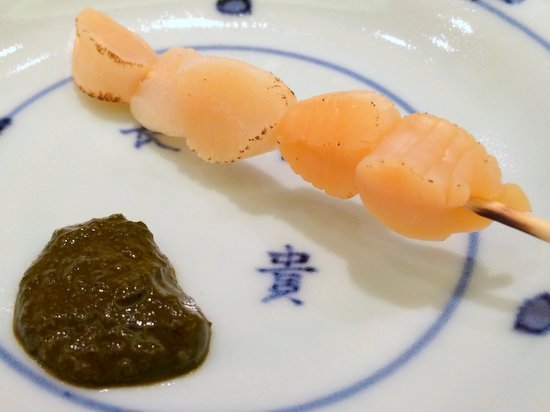
(C) Kobashira with awabi kimo (above) – Adductor muscles of clam with abalone liver. Clam was skewer grilled (yakitori). And I really liked the slight smokiness from the clam and chef Oshino’s creativity in using abalone liver as its accompanying sauce. So good.

(D) Aoyagi (above) – Orange clam.
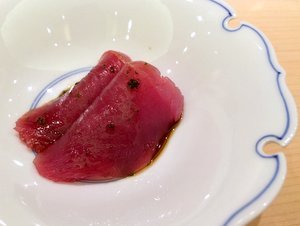
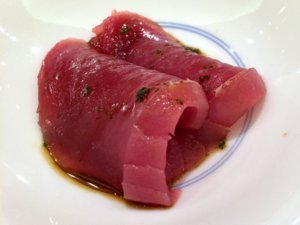
(E) Katsuo (above) – Bonito.
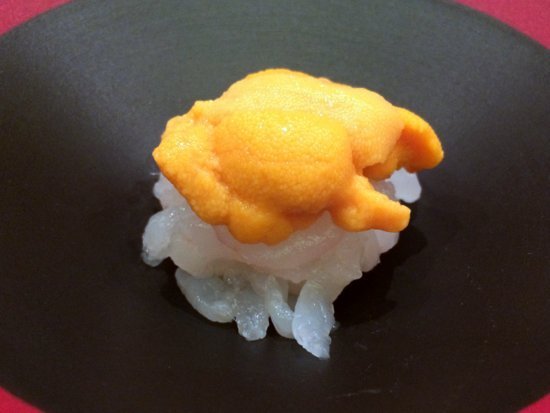
(F) Shiro-ebi with uni (above) – Baby white shrimp with sea urchin. One of my favourite combinations!
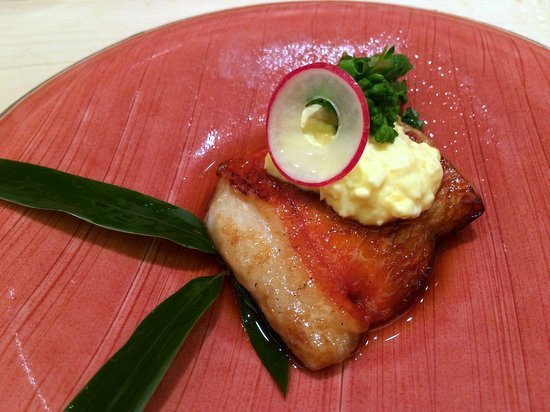
(G) Kinmedai (above) – Big-eye snapper. Served with gravy and topped with egg-mayonnaise. Except for the Japanese kai-lan, I really enjoyed this dish.

(H) Momotaro (above) – Tomato. I did not really like this. Not because I am a bring-on-the-meat person, but it was acidically sour. But I finished this especially after witnessing the behind-the-scene; A long knife was used to slice off the skin of the small tomato, thinly. Wow. That’s some skill.

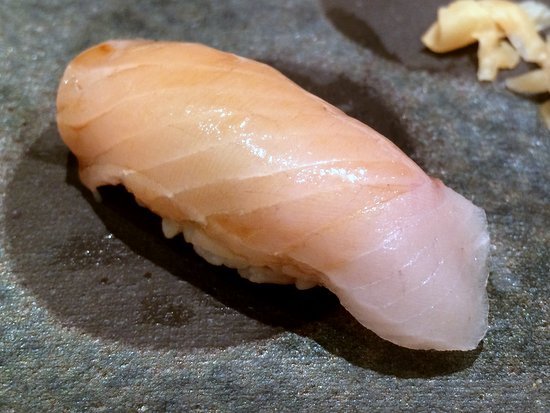

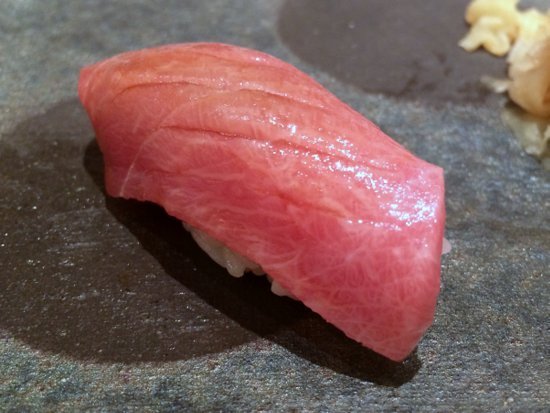
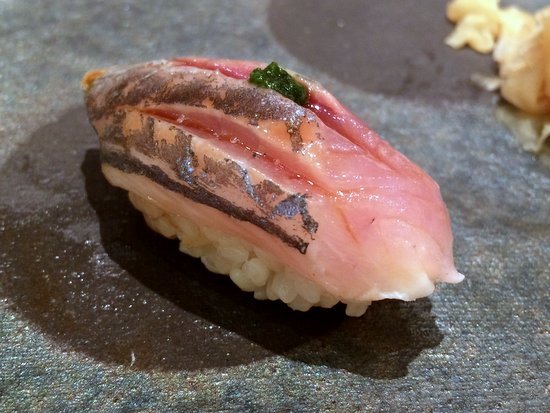

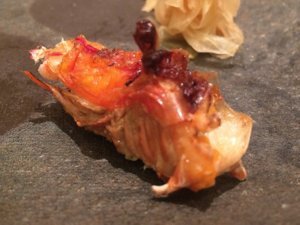
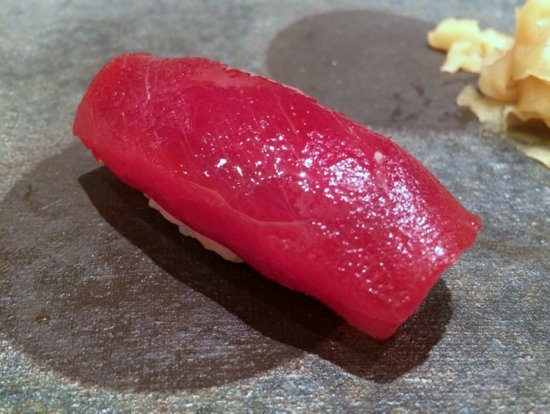
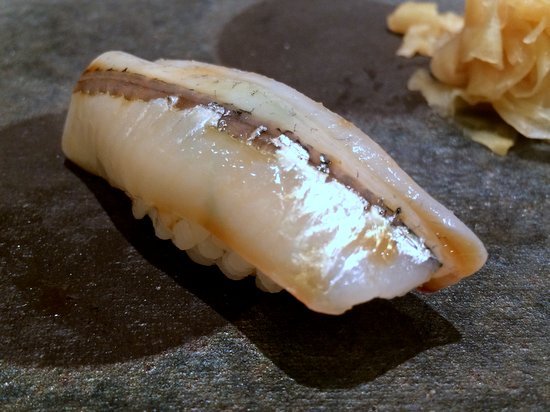
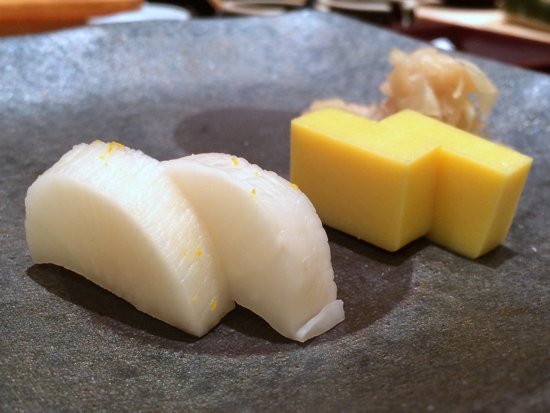
(I) Assorted sushi & makimono temaki roll (above) – Kanpachi (greater amberjack), sawara (Spanish mackerel), wakaremi (dorsal fin of tuna), shimofuri-otoro (shimofuri being the cut of partial-chutoro & partial-otoro of tuna where it has snowflake-like marbling), aji (jack mackerel) topped with spring onion and ginger puree, kuruma-ebi (tiger prawn) served boiled and halved for ladies, maguro zuke (marinated suka tuna), sayori (needlefish), temaki roll (hand roll) of crisp seaweed wrapped around warm shari (sushi rice) and strips of otoro & cucumber, preserved pickles (foreground in last picture) and custard-styled tamago (egg) (background in last picture). I especially enjoyed the sushi course of my omakase. I got to try many premium cuts like wakaremi and shimofuri-otoro which were my firsts. And it was indeed the shari (sushi rice) that set Shinji apart from their counterparts. The shari had more flavour with its stronger vinegar taste. And it’s because of this that one must eat sushi in the correct manner where the topping should touch one’s tongue first. Yes, it makes a difference. A newly-made friend (waves to @lailian27) who also frequents Shinji shared with me of how every sushi is made of 150 rice grains. Oh yes, apparently someone verified that fact too! And that fact showed the consistency in every sushi. Wow.
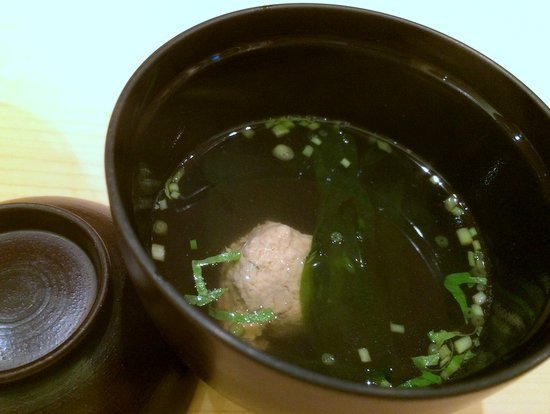
(J) Negima-jiru – Scallions and tuna soup. With kelp too, tuna was served in the form of a meatball.


(K) Dessert (above) – Our omakase set was to come with fruit (melon). However, it being spring, Shinji had its seasonal dessert of monaka which is a Japanese sweet with filling sandwiched between thin, crisp wafers. Shinji’s version was with azuki beans, matcha ice cream and glutinous rice that’s pink from sakura essence. I requested to change my dessert of fruit to monaka. But chef Oshino was very nice to give me both. All thanks to my friend who’s a regular too! Keke. Sakura leaf (not pictured) was also given for one to wrap the monaka with. But I chose not to cause I did not like the slightly bitter taste the leaf leaves behind.


2) Chirashi, $50 – Rice which was uniformly mixed with a generous amount sea urchin, and further topped with minced tuna. So good.
I totally enjoyed my lunch. It was one of my most memorable Japanese meals in Singapore. We were spoilt by chef Oshino with the beautifully executed dishes. And remember how I always feel short changed when vegetables were served for my omakase? I’m so glad I was given none at Shinji. Well, just 1 dish of tomato is acceptable for some balance. Ha!
And service was impeccable. Staff were friendly and polite. The same goes for the chefs too. Chef Oshino had a pretty good humour! But what I really liked about Shinji was the ambience. It was very… Tranquil. I was able to detach myself from what’s happening beyond the four walls and concentrate on the meal. I finally understand why friends flock to Shinji whenever they’re stressed. Haha.
As I came with a friend who frequents Shinji, my omakase meal was somewhat customised to her preference. Which wasn’t a problem cause we’ve similar palates. Keke. Chef Oshino served us 2 different types of sea urchin cause my friend loves sea urchin. So really, to have a memorable omakase meal, even if it’s one first time at Shinji, always let the chef know one’s likes and dislikes. Or be a regular at Shinji (which I think isn’t difficult cause one really do crave for their sushi) and have one’s preference remembered by the chefs. Ha!
Sushi? Shinji, for sure! They have reasonably priced sets which wouldn’t cost one to break the bank. For lunch, 9 and 15 pieces of nigiri sushi are priced at $75 and $180 respectively. If not, there’s 15 pieces at $220 for dinner. All come with maki sushi, soup and dessert. =)
|
SHINJI BY KANESAKA
|
|||
|
1 Beach Road, Raffles Hotel, #02-20, Singapore
6338 6131, Website
|
|||
|
Overall: 8
|
|||
|
Opening hours:-
|
Food/Beverage: 9
|
||
|
Mon – Sat : 12:00 – 15:00 (Lunch)
|
Ambience: 8
|
||
|
Mon – Sat : 18:00 – 23:00 (Dinner)
|
Value: 8
|
||
|
Service: 8
|
|||
|
* Closed on Sun
|
|||
UPDATE 1: Restaurant was awarded 1 Michelin star by Michelin Guide Singapore 2016.
UPDATE 2: Restaurant has moved to 76 Bras Basah Rd, Carlton Hotel, Lobby Floor.
UPDATE 3: Restaurant was awarded 1 Michelin star by Michelin Guide Singapore 2017.
UPDATE 4: Restaurant was awarded 1 Michelin star by Michelin Guide Singapore 2018.


